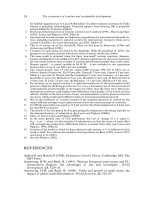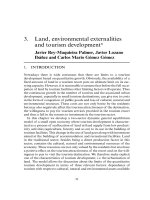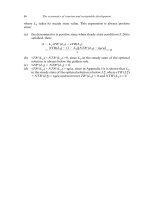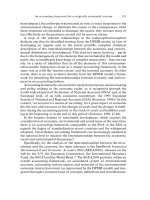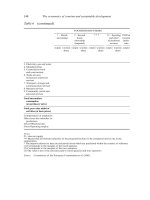THE ECONOMICS OF MONEY,BANKING, AND FINANCIAL MARKETS 384
Bạn đang xem bản rút gọn của tài liệu. Xem và tải ngay bản đầy đủ của tài liệu tại đây (34.34 KB, 1 trang )
352
PA R T I V
APP LI CAT IO N
The Management of Financial Institutions
Hedging with Interest-Rate Futures
As the manager of the First Bank, you can also use interest-rate futures to hedge
the interest-rate risk on its holdings of $5 million of the 6s of 2030 (Canada bonds
with a 6% coupon rate that mature in 2030).
To see how to do this, suppose that in March 2010, the 6s of 2030 are the longterm bonds that would be delivered in the Montreal Exchange s Canada bond
futures contract expiring one year in the future, in March 2011. Also suppose that
the interest rate on these bonds is expected to remain at 6% over the next year so
that both the 6s of 2030 and the futures contract are selling at par (i.e., the $5 million
of bonds is selling for $5 million and the $100 000 futures contract is selling for
$100 000). The basic principle of hedging indicates that you need to offset the long
position in these bonds with a short position, so you have to sell the futures contract. But how many contracts should you sell? The number of contracts required
to hedge the interest-rate risk is found by dividing the amount of the asset to be
hedged by the dollar value of each contract, as is shown in Equation 1 below.
NC *VA/VC
(1)
where
NC * number of contracts for the hedge
VA * value of the asset
VC * value of each contract
Given that the 6s of 2030 are the long-term bonds that would be delivered in
the Montreal Exchange s Canada bond futures contract expiring one year in the
future and that the interest rate on these bonds is expected to remain at 6% over
the next year, so that both the 6s of 2030 and the futures contract are selling at par,
how many contracts must First Bank sell to remove its interest-rate exposure from
its $5 million holdings of the 6s of 2030?2
If
VA * $5 million
VC * $100 000
Then
NC * $5 million/$100 000 * 50
You therefore hedge the interest-rate risk by selling 50 of the Canada bond futures
contracts.
Now suppose that over the next year, interest rates increase to 8% due to an
increased threat of inflation. The value of the 6s of 2030 that the First Bank is holding will then fall to $4 039 640 in March 2011.3 Thus, the loss from the long position
in these bonds is $960 360 as shown below:
2
In the real world, designing a hedge is somewhat more complicated than the example here because
the bond that is most likely to be delivered might not be a 6s of 2030.
3
The value of the bonds can be calculated using a financial calculator as follows: FV * $5 000 000,
PMT * $300 000, I * 8%, N * 19, PV * $4 039 640.





